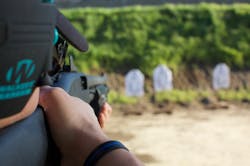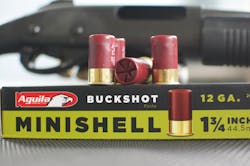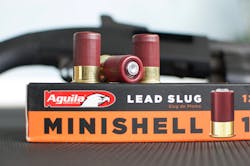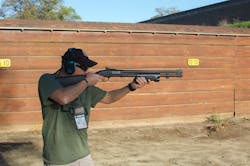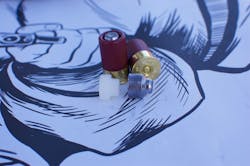Review: Aguila Ammunition's Minishells
Double the capacity of shotguns
Minishells were designed to reduce recoil. Although I did not test the birdshot Minishells, reduced recoil is an important factor for shot gunners who practice all day long. The shot shells, ranging from 7 1/2 to size 9 shot expel a 5/8 ounce (18 g) payload at an estimated 1,200 feet per second.
The Minishell Buckshot uses a hybrid load of 4B and 1B shot. There are seven pellets of 4B and four pellets of 1B. The payload weighs 19 grams.
In both my Remington 870 and my Mossberg 590, the Minishell Buckshot pellets were good at short distances. As the distances went beyond 10 yards, it was hard to keep them on a torso-sized target. This is pretty typical for scattergun loads. Although the shot tended to leave the ballistic gelatin, a combination of 4B and 1B is an excellent choice for this type of load, especially for law enforcement. First, the smaller size shot fills the empty spaces for the larger, creating a consistent pattern. Second, this combination seemed to expend energy a lot quicker, making it safer for things that are not targets.
For both the Buckshot and Slug loads, we all noticed lighter recoil. More interestingly, the loads were a little quieter and didn’t produce a lot of flash. They weren’t any cleaner than standard shotgun loads, but they weren’t any dirtier, either.
Although I don’t think that Aguila designed the Minishells for law enforcement purposes, the product loans itself well for police use.
When I tested the Minishell Slugs, they did over-penetrate my ballistic gelatin, but not at the same rate a full power load does. The first slug I sent through gelatin went through 2x12 inch blocks and then barely tapped the backstop down range.The Minishell Slug uses a 25 gram slug that has a slightly concave base, with a thick polymer wad that fits neatly into this base. This 7/8 ounce, 25 gram projectile is well-designed, with a large frontal surface area that is flat. Although I tested these shells in several smoothbore shotguns, the design of the slug may work in a rifled slug barrel because of the engagement surface of the projectile.
When I ran the slugs through my cylinder bore 18 inch barrels, they averaged about 1,100 feet per second, slightly slower than the advertised 1,250 feet per second. While some shotgun slug loads can reach 3,200 foot pounds, they average around 2,600 foot pounds—a very large chunk of energy.
Using my Oehler Chronograph, I calculated 1,037 foot pounds for the Minishell Slugs. Before anyone thinks that this is lightweight terminal ballistics, consider this—some of the best 45 ACP cartridges achieve around 400 foot pounds of energy.
I’m only using these numbers to place this into perspective. Remember that the method in which the energy is delivered is much more important. For example, a really good hunting Broadhead can weigh between 400 and 500 grains. A baseball weighs around 2,240 grains, give or take. Using raw calculations, the baseball at 120 feet per second has more energy than the arrow at 220 feet per second. I wouldn’t really like to “take one for the team” with either, but, if forced, I’d stand in front of pitched ball more readily.
High performance cartridges and shot shells rely on how efficiently the energy is transferred from the projectile to the target. With shotgun shells, this is a real problem.
If you’ve ever spent any time watching videos of people testing shotgun loads, you’ll notice something in common—the ballistic gelatin rarely holds the slug, or even the buckshot. The most common trait of all shotgun loads used for defense is dangerous over-penetration. I have yet to test a slug that will deliver all of its energy within the desired 18 inches of ballistic gelation.
Aguila’s Minishells are slower, and although they still over-penetrated, they seem to expend more energy than full power loads in ballistic gelatin. These may be the closest thing to a law enforcement solution that I have tested when it comes to using slugs.Why use slugs in the first place?
For law enforcement, slugs have close to carbine-like accuracy within about 50 yards. My shotguns have always been sighted in for 100 yards. Depending on the slug, I can address that 100 yards within a three-inch circle. A good slug can penetrate most walls and still have considerable energy left for the projectile to do its work. Most 12 gauge slugs will run from 1,300 to 2,400 feet per second with a one ounce projectile. For non-rifled slugs, one can expect between 1,600 and 1,800 feet per second on the average. Within 50 yards, even non-stabilized slugs will deliver reliable accuracy.
I shot the slugs at 25 yards, off hand, standing. The purpose of shooting off hand was to see how quickly one could pump accurate fire down range. When I looked at my target, I was initially disappointed. There appeared to be an elongated hole in one area, then two of the holes were 4 inches away. At this point, I was wondering if it was worth continuing the test. As it turned out, the elongated hole was actually two slugs on top of each other. The other two holes were the disc-shaped wad at the base of the slugs. The slugs turned out to be pretty accurate.
Limitations
Minishells turn my Mossberg 590 Tactical into a 19 shot 12 gauge. When I first began testing, it took a certain “feel” to allow the short shells to feed reliably. If one works the slide slowly, the shells tend to hang up in the elevator, the part that raises the shell from the magazine to the bolt assembly. Using a deliberate stroke fed the shells consistently. OPSol Texas makes a simple polymer device that clips into the elevator assembly. It shores up the play when shorter shells are used. Since this device is inexpensive and appears to work reliably, I recommend that agencies look into keeping it in their inventory.
Just for curiosity’s sake, I tried the Minishells in a semi-automatic shotgun. I didn’t think it would work. It didn’t.
There has been some discussion about shortening the distance between the ejector and the chamber on pump shotguns in order to easily accommodate Minishells. Because of the abbreviated shells they cleared the chamber quickly but hit the ejector solidly and ejected reliably. Modifying or changing the position of the ejector would preclude using full-sized shells.
Are they worth it?
I do a little bit of shotgun shell reloading and it takes a little bit of work to find a consistent load that produces desirable performance. Getting the same amount of performance out of half the space, especially powder space, is tricky indeed.
Cartridges are astronomically better than they were 10 years ago. The things that we considered expensive custom upgrades on firearms years ago are now standard production, and powder companies have mastered the art of load density, clean burning and efficiency.
Minishells are maximized performance in a smaller package. They do exactly what Aguila set out to do. Their recoil is noticeably lighter and their performance is similar to full-length shells designed for lower recoil. They double the capacity of any tube fed pump action shotgun, with little modification and they cost about the same as any other premium ammunition.
Law enforcement officers use shotguns to bridge the gap between the handgun and the rifle. The trend has been going more towards carbines than shotguns lately. Still, shotguns have a definite utility as a law enforcement tool. Given the inherent advantages, we may see Aguila Minishells on the street.
About the Author

Officer Lindsey Bertomen (ret.), Contributing Editor
Lindsey Bertomen is a retired police officer and retired military small arms trainer. He teaches criminal justice at Hartnell College in Salinas, California, where serves as a POST administrator and firearms instructor. He also teaches civilian firearms classes, enjoys fly fishing, martial arts, and mountain biking. His articles have appeared in print and online for over two decades.
